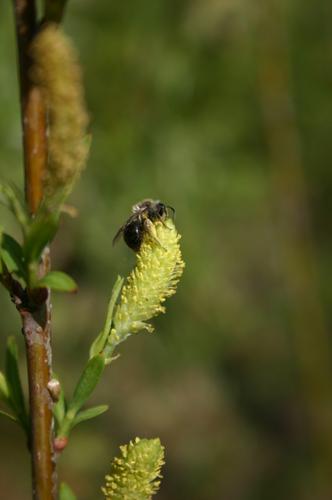当前位置:
X-MOL 学术
›
Ann. Appl. Biol.
›
论文详情
Our official English website, www.x-mol.net, welcomes your feedback! (Note: you will need to create a separate account there.)
Bee foraging preferences on three willow (Salix) species: Effects of species, plant sex, sampling day and time of day
Annals of Applied Biology ( IF 2.6 ) Pub Date : 2020-07-05 , DOI: 10.1111/aab.12621 Alex Mosseler 1 , John Major 1 , Don Ostaff 1 , John Ascher 2
Annals of Applied Biology ( IF 2.6 ) Pub Date : 2020-07-05 , DOI: 10.1111/aab.12621 Alex Mosseler 1 , John Major 1 , Don Ostaff 1 , John Ascher 2
Affiliation

|
Our objective was to examine how bee foraging preferences on dioecious willows are influenced by plant sex, time of day, by sampling date on multiple sites and across different willow species. In a common garden experiment examining diurnal pollinator visitation patterns of Andrena bees (andrenids), there was a strong preference for male willow plants: 87% of visitations on male plants of Salix eriocephala (ERI) and 71% on males of S. interior (INT). The significant plant sex × time of day interaction was not a result of a change in bee preference for a certain plant sex during a certain part of the day but rather the result of diurnal changes in the magnitude of the preference of andrenid bees for male willow plants. Visits to male flower catkins were highest in the morning and early afternoon, peaking at midday. Visits to female catkins showed a more uniform, lower frequency visitation pattern throughout the day. In a larger field test at a reclaimed former coal mine site, which included S. cordata (COR) as well as ERI and INT, there were no sampling date × plant sex or sampling date × plant sex × willow species interactions. This indicates no plant sex switching behaviour by sampling date for the three willow species. Preference for male plants was greatest on the first sampling day and the proportion of male preference continued to decline until the fourth and final sampling day. On the mine site, 17 of the 25 Apoidea bee species identified were andrenids, and they represented 92% of the 744 individual bees collected while foraging on willow catkins. In addition, the overall number of observed and collected Apoidea bees visiting available flowering willow plants showed that the preference for male plants was 83%, 72% and 91%, for ERI, INT and COR, respectively. We discuss possibilities for promoting populations of native bees to increase commercial fruit and berry crop pollination by using willows as natural sources of pollen and nectar, thereby reducing costs of production associated with the annual importation of commercial bees.
中文翻译:

三种柳树(Salix)上的蜜蜂觅食偏好:物种,植物性别,采样日和时间的影响
我们的目的是研究对雌雄异体的柳树觅食偏好如何受到植物性别,一天中的时间,在多个地点和不同柳树种类上采样日期的影响。在一项常见的花园实验中,研究了雄性蜜蜂(雄性类)的昼夜授粉媒介访问方式,其中雄性杨柳植物极受青睐:柳顶柳(ERI)的雄性植物访视次数为87%,南室内雄性为71%。(INT)。显着的植物性别×一天中的时间交互作用不是由于一天中特定时段蜜蜂对某种植物性别的偏好发生变化,而是雄性蜜蜂对杨柳的偏好程度发生日变化的结果植物。雄花柳絮的造访次数最高的是早上和下午,最高是中午。对雌性柳絮的访问在一天中显示出更均匀,频率更低的访问模式。在开垦的旧煤矿现场进行的更大范围的现场测试,其中包括S. cordata(COR)以及ERI和INT,没有采样日期×植物性别或采样日期×植物性别×柳树物种之间的相互作用。这表明这三种柳树的采样日期均未显示植物性别转换行为。在第一个采样日,对雄性植物的喜好最大,直到第四个和最后一个采样日,雄性喜好的比例持续下降。在矿场上,发现的25种Apoidea蜜蜂中有17种是雄性类动物,它们在捕捞柳絮时采摘的744只蜜蜂中占92%。另外,观察和收集的可访问的开花柳树植物的Apoidea蜜蜂的总数表明,对ERI,INT和COR的偏好性分别为雄性植物的83%,72%和91%。
更新日期:2020-07-05
中文翻译:

三种柳树(Salix)上的蜜蜂觅食偏好:物种,植物性别,采样日和时间的影响
我们的目的是研究对雌雄异体的柳树觅食偏好如何受到植物性别,一天中的时间,在多个地点和不同柳树种类上采样日期的影响。在一项常见的花园实验中,研究了雄性蜜蜂(雄性类)的昼夜授粉媒介访问方式,其中雄性杨柳植物极受青睐:柳顶柳(ERI)的雄性植物访视次数为87%,南室内雄性为71%。(INT)。显着的植物性别×一天中的时间交互作用不是由于一天中特定时段蜜蜂对某种植物性别的偏好发生变化,而是雄性蜜蜂对杨柳的偏好程度发生日变化的结果植物。雄花柳絮的造访次数最高的是早上和下午,最高是中午。对雌性柳絮的访问在一天中显示出更均匀,频率更低的访问模式。在开垦的旧煤矿现场进行的更大范围的现场测试,其中包括S. cordata(COR)以及ERI和INT,没有采样日期×植物性别或采样日期×植物性别×柳树物种之间的相互作用。这表明这三种柳树的采样日期均未显示植物性别转换行为。在第一个采样日,对雄性植物的喜好最大,直到第四个和最后一个采样日,雄性喜好的比例持续下降。在矿场上,发现的25种Apoidea蜜蜂中有17种是雄性类动物,它们在捕捞柳絮时采摘的744只蜜蜂中占92%。另外,观察和收集的可访问的开花柳树植物的Apoidea蜜蜂的总数表明,对ERI,INT和COR的偏好性分别为雄性植物的83%,72%和91%。


























 京公网安备 11010802027423号
京公网安备 11010802027423号